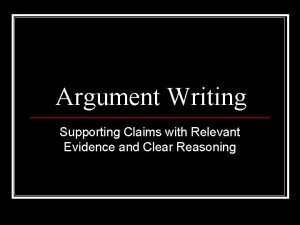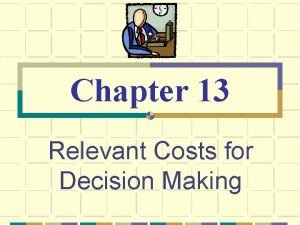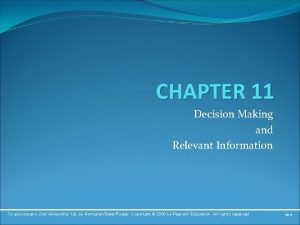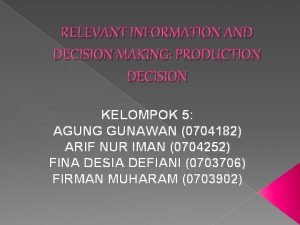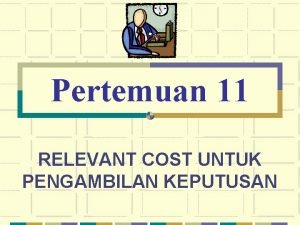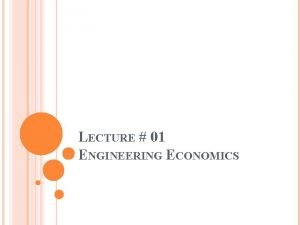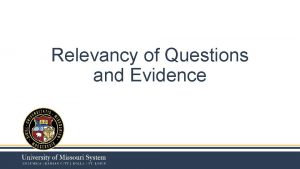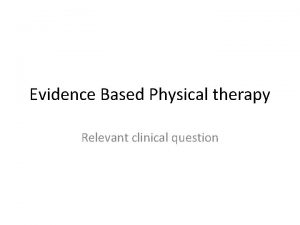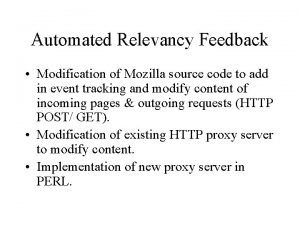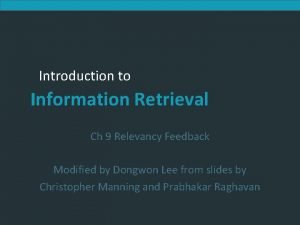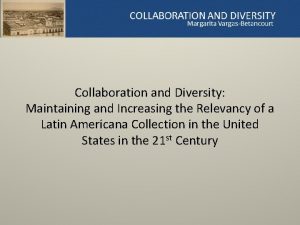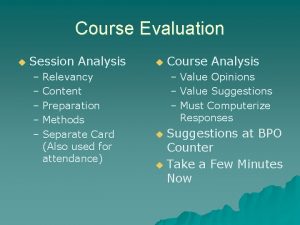Chapter 6 Relevancy Relevant Evidence Relevant Evidence has



















- Slides: 19

Chapter 6 Relevancy

Relevant Evidence �Relevant Evidence has any tendency to prove or disprove a disputed fact in a case. �Relevancy is the first test for the admissibility of evidence.

Common Areas of Relevant Evidence 1. Motive: § The moving cause or reason why a crime is committed. § Motive isn’t required as part of the corpus delicti of a crime. However, motive is relevant when proving: ü Specific intent (premeditation / aforethought). ü General intent (maliciously). ü Enhancements (hate / gang crimes)

2. Capacity: q One’s mental ability to form criminal intent or understand a duty imposed by law. ü Children under 14 years: presumed (rebuttable )incapable of committing a crime in absence of clear proof he/she knew the wrongfulness of one’s act (See text for examples). ü Persons Who Are Mentally Incapacitated: is a person without mentality and lacks the ability to form criminal intent or understand a duty imposed by law (See text for examples).

ü Insanity: persons found insane at the time of committing a crime can be judged not legally responsible for their actions. The defendant carries the burden of proof. CA uses the M’Naughten Rule – due to mental defect or disorder he/she was incapable of distinguishing right from wrong at the time of the commission of the act and was incapable of knowing or understanding the nature of one’s act. Also known right from wrong test (See text for examples).

ü Voluntary Intoxication: includes the voluntary ingestion, injection, or taking by any other means of any intoxicating liquor, drug, or other substance. Persons who are voluntarily intoxicated are still legally responsible for their actions. (See text for examples). Note: can be used as a mitigating factor when determining whether or not the defendant actually formed a required specific intent when charged with murder. Cannot be used as a defense to the crime.

ü Unconscious of the Act: includes cases where the defendant was involuntarily intoxicated, suffering the effects of disease, delirium, fever, head injury, epilepsy, postpartum psychosis, or somnambulism (sleep walking) when a crime occurred. (See text for examples). ü Ignorance or Mistake of Fact: person who commit a criminal act out of ignorance of the law or mistake of fact can be judged not criminally responsible for their actions. (See text for examples).

ü Acting Under Threats or Menaces: a person is not criminally liable, when acting under a direct and immediate threat of death or great bodily injury, and one is coerced into committing a crime (See text for examples). 3. Opportunity to Commit a Crime: the defendant’s physical presence in or about a crime scene is relevant evidence. Other areas include: ü Prior threats of ill will towards a victim.

ü Special knowledge of location of valuables, safe combination, etc. ü Possessing tools or other instrumentalities. 4. Threats or Expressions of Ill Will by the Accused: this area includes verbal or written threats communicated to the victim or others, whether prior to, during, or after the crime. 5. Means for Committing the Offense: this area includes possessing the fruits of a crime, instrumentalities of a crime, and contraband (FICE). Also, writings related to the crime (See text for examples).

6. Physical Evidence Linking the Defendant to the Crime Scene: includes the entire range of trace, perishable, and other types of scientific evidence recovered under theory of transfer (FICE) (See text for examples). 7. Consciousness of Guilt Factors: Conduct, statements, and other acts by the accused which tend to prove a guilty mind (admission by conduct) examples include: ü ü ü FLEEING FROM THE CRIME SCENE RESISTING ARREST REFUSING TO PROVIDE OR ATTEMPTING TO DESTROY EVIDENCE THREATENING A WITNESS ATTEMPTING TO ESCAPE OR FLIGHT TO AVOID PROSECUTION

q The trier of fact may draw an inference of consciousness of guilt if the defendant doesn’t offer an explanation for the conduct. q No consciousness of guilt can be argued with asserting a constitutional right (refusing a consent search or Miranda assertion).

CONSCIOUSNESS OF GUILT IS THERE AN EVIDENCE PRESERVATION PROBLEM HERE? HOW COULD THE SECONDARY EVIDENCE RULE (WRITINGS) HELP IN THIS CASE?

CONSCIOUSNESS OF GUILT FROM JAIL - TWICE TRIED TO HIRE A HIT MAN TO KILL THE VICTIM TO PREVENT HER TESTIMONY. TWICE ELUDED POLICE IN AUTO CHASES. FOUND BY POLICE DOG HIDING IN ATTIC. “ITS NOT RAPE WHEN ITS YOUR GIRL FRIEND”.

CONSCIOUSNESS OF GUILT AFTER A CAR CHASE, SUSPECT CRASHED THROUGH A FENCE AND FLED HIS VEHICLE. HE WAS FOUND 1 -1/ 2 HOURS LATER, HIDING UNDER PLASTIC SHEETING OF A MANURE PILE AT A LOCAL DAIRY!

8. Admissions or Confession: an admission is a statement by the accused which acknowledges a fact of relevant evidence in a case. A confession is a statement by the accused which acknowledges criminal guilt (See text for examples). 9. Credibility Issues Involving a Witness: this area involves evidence of impeachment and rehabilitation during the witness examination process.


10. Hearsay Evidence: is evidence of a statement, that was made other than by a witness while testifying at a hearing, that is offered to prove the truth of a matter. 11. Modus Operandi: is the “unique signature” or distinctive manner in which a criminal commits an offense and is relevant evidence. Can be offered to prove opportunity, motive, intent, or to rebut a capacity defense, i. e. : Domestic Violence, Arson, Murder, Narcotic Sales, Robbery and Sex crimes (See text for examples).

12. Propensity Evidence: evidence of prior acts or crimes from which a jury could infer that if the defendant committed similar past crime(s), that he/she could commit the present crime as well. Note: as a general rule, evidence of character, reputation, or past instances of conduct are inadmissible to prove present conduct in a criminal case except:

ü Reputation for Violence: (See text for examples). ü Commission of Past Sexual Crimes: (See text for examples). ü Past Acts of Domestic Violence: (See text for examples). ü Past Acts of Child Abuse: (See text for examples).
 Contextual relevancy
Contextual relevancy Relevant evidence in writing
Relevant evidence in writing Steps in decision making
Steps in decision making Relevant cost for decision making solution chapter 13
Relevant cost for decision making solution chapter 13 Chapter 11 decision making and relevant information
Chapter 11 decision making and relevant information Decision making and relevant information
Decision making and relevant information What is a primary source
What is a primary source Primary evidence vs secondary evidence
Primary evidence vs secondary evidence Secondary sources
Secondary sources Primary evidence vs secondary evidence
Primary evidence vs secondary evidence Primary evidence vs secondary evidence
Primary evidence vs secondary evidence Are fibers class evidence
Are fibers class evidence Class evidence vs individual evidence
Class evidence vs individual evidence Explain how class evidence can have probative value.
Explain how class evidence can have probative value. A pair of latex gloves was found at a crime scene
A pair of latex gloves was found at a crime scene Appeal to pity examples
Appeal to pity examples Irrelevant sentence quiz
Irrelevant sentence quiz Decision making and relevant information
Decision making and relevant information Relevant cost adalah
Relevant cost adalah Consider all relevant criteria
Consider all relevant criteria

